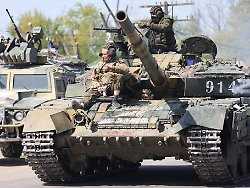Parallels to 1943
Why the Russian pincer attack in Donbass is faltering
By Janis Peitsch
05/07/2022 11:59 am
With a battle of encirclement, Russia wants to destroy Ukrainian units in the Donbass. But the advance of the Kremlin associations is progressing slowly for a number of reasons. The battles near the town of Izyum bring back memories of a World War II battle that took place nearby.
Since mid-April, the Russian armed forces have been intensifying their attacks in Donbass and southern Ukraine. But even after three weeks of heavy fighting, the second phase of the Russian invasion does not seem to be gaining momentum. On the contrary: on the hard-fought front near Kharkiv, the Ukrainian defenders launched successful counterattacks.
The advances of the Ukrainian army also threaten the Russian pincer movement in the Donetsk region. In the past few days, Russian military planners have concentrated strong forces near Izyum in order to press ahead with the attack from there in a southerly direction. According to the Ukrainian general staff, Moscow is attempting to attack the cities of Sloviansk and Kramatorks to cut off Ukrainian forces in the advanced front arc further east.
But despite intensive efforts, the Russian armored columns have been making slow progress so far. This may also be due to the terrain. Isjum is surrounded by two larger forest areas that are difficult for military vehicles to pass through. In addition, the river Siverskyj Donets, which flows around the city, narrows the attack corridor to the south. To make matters worse, Ukrainian forces have deployed deep defense lines in the region.
A Vpublished analysis of the Austrian Armed Forces also mentions other factors. Accordingly, the forces of the Russian side in the sector of the front are not sufficient for a successful offensive. The military experts put the number of Ukrainian battalions in the combat area at 48, while the number of formations in Moscow is estimated at only 68 battalions. According to current theory, however, a ratio of 1:4 is necessary, according to Vienna.
While the Russian side has so far relied on massive bombardments to enable attacks by ground forces, the Ukrainians are concentrating on mobile defense tactics, according to the analysis. As soon as the artillery fire begins, the Ukrainian soldiers retreat to their dugouts or retreat to the rear, only to reoccupy the front lines shortly after the artillery strike. Breaking through Russian units are then fought with reserve armored formations stationed behind the battle line.
The current battles thus show parallels to the Battle of Kursk in World War II, which also took place in the region. In the summer of 1943, the Wehrmacht tried to encircle the Soviet front apron north of Kharkiv with “Operation Zitadelle”. At that time, Moscow was well informed about the German attack plans through intelligence information, which enabled the Red Army to build up deep defensive positions on the flanks in months of work. The German offensive ultimately failed after just a few days.
